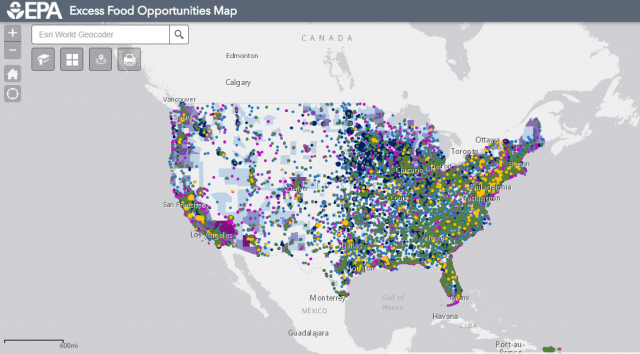EPA’s Excess Food Opportunities Map – A National Tool to Divert Excess Food from Landfills
Published January 28, 2021

Food waste is the single largest component in our daily trash. American landfills receive about 73 billion pounds of food waste every year.
In 2015, EPA announced the first ever domestic goal to reduce food loss and waste across the country. By reducing food waste, the United States can help feed the hungry, save money for families and businesses, and protect the environment. Led by the U.S. Department of Agriculture (USDA) and EPA, the federal government is working with communities, organizations, and businesses along with partners in state, tribal and local government to reduce food loss and waste by fifty percent by the year 2030.
In an effort to meet this goal, EPA scientists across the Agency successfully developed a mapping tool for food waste data that is commercially or publicly available. EPA’s Excess Food Opportunities Map is an easy-to-use, interactive map that identifies and displays locations of nearly 1.2 million potential generators and recipients of excess food, so that food is not wasted. Since 2018, EPA's Office of Land and Emergency Management’s Sustainable Management of Food team has hosted and maintained the map. Steve Rock, an EPA environmental engineer and one of the project leads, worked with colleagues to design what the map would look like and determine what data to collect and use.
“It’s a visual database and what we were trying to do is help organizations and groups with excess food find food rescue groups, composters, and anaerobic digesters,” stated Rock.
The map allows the user—states, communities, advocacy groups, food recycling organizations, entrepreneurs, and the facilities and businesses that produce or accept food waste to estimate the amount of excess food or food waste in their communities and create connections between generators and the facilities and organizations that can repurpose it.
“They didn’t know how to find each other,” Rock said. “In the last six years, a lot of networking has happened and now it’s easier to find organizations to take food. One of the reasons is because of the map we developed.”
The map is even more important now because of the disruptions to the food supply chain across the United States occuring due to the COVID-19 pandemic. Food that was potentially going to landfills is being redirected to food banks and food pantries.
The map provides easily accessible information to identify opportunities for diverting excess food or food waste from landfills and putting toward beneficial uses. It works as an ‘online matching service’ to identify users or recipients of excess food. The map links those who own and run large compost sites and anaerobic digestion facilities with those looking to dispose of organic waste, including excess food, and can also be used to link businesses who have food that could be donated to food banks.
This mapping tool is designed to help businesses and organizations identify opportunities for new partnerships and to help address changes in the food supply chain. For example, the map could be used to find potential food service or educational institution partners that may have available kitchens that could be used to store or preserve excess food or transform it into prepared meals; or to find businesses, such as caterers, that may have available refrigerated trucks to help transport excess food for food banks.
The development of the tool is an example of EPA’s ability to conduct innovative, applied research with the potential for widespread, profound impacts. In April 2020, EPA released a new version (2.1), which updates the anaerobic digestion facilities and communities with residential curbside food scrap collection (known as source separated organics programs). The map now contains more than 1,600 anaerobic digestion facilities that are point mapped, and over 200 communities with residential curbside food scrap collection. Where available, EPA provides information on types of feedstock that are accepted by each facility or program.
Working with USDA and partners in the states and tribes, this tool is just one of the ways EPA plans to meet the 50 percent reduction goal by working with leaders in the food system to promote action, and bring more successful interventions and tools to advance the sustainable management of food.
Questions?
Contact Claudia Fabiano with questions or feedback on the Excess Food Opportunities Map.
